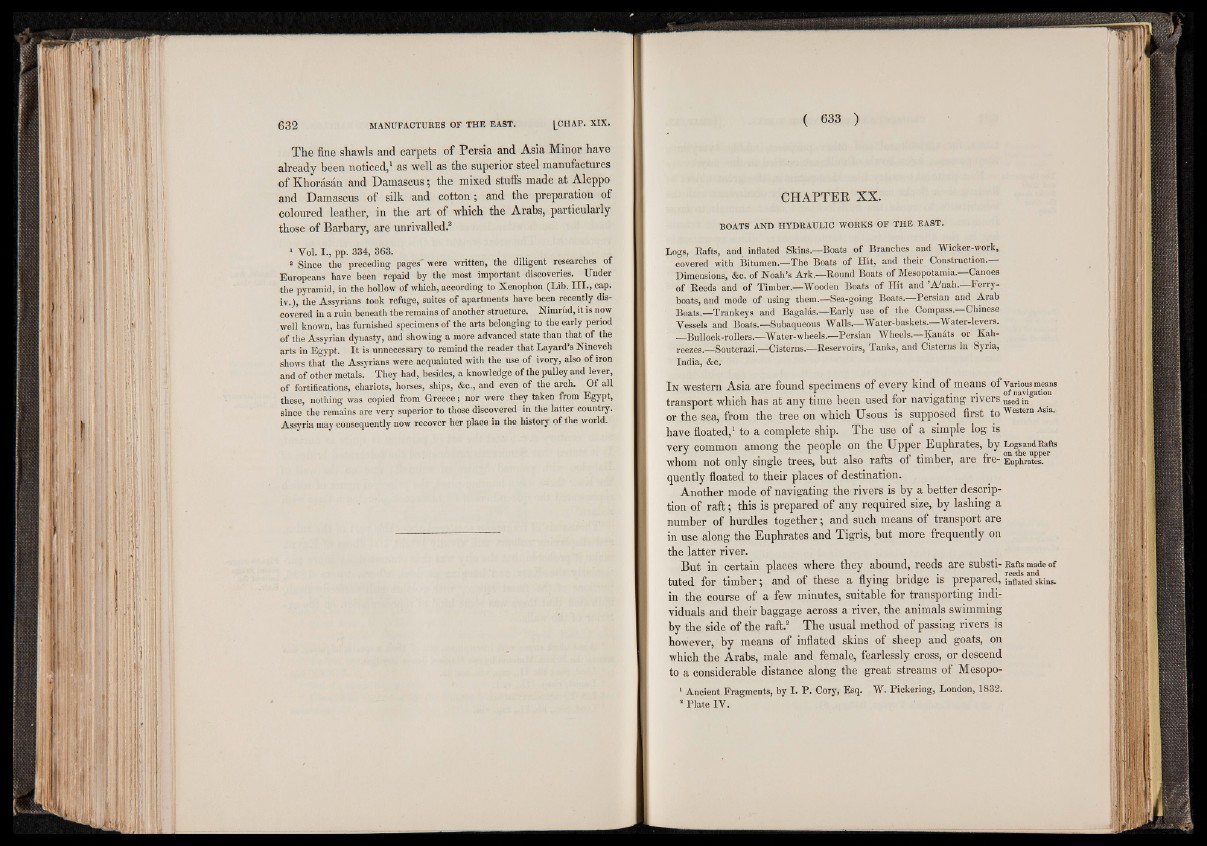
The fine shawls and carpets of Persia and Asia Minor have
already been noticed,1 as well as the superior steel manufactures
of Khorasan and Damascus ; the mixed stuffs made at Aleppo
and Damascus of silk and cotton ; and the preparation of
coloured leather, in the art of which the Arabs, particularly
those of Barbary, are unrivalled.2
1 Vol. j p pp. 334, 363.
a Since the preceding pages' were written, the diligent researches of
Europeans have been repaid by the most important discoveries. Under
the pyramid, in the hollow of which, according to Xenophon (Lib. I I I . , cap.
iv.), the Assyrians took refuge, suites of apartments have been recently discovered
in a ruin beneath the remains of another structure. Nimrûd, it is now
well known, has furnished specimens of the arts belonging to the early period
of the Assyrian dynasty, and showing a more advanced state than that of the
arts in Egypt. I t is unnecessary to remind the reader that T.ayard’s Nineveh
shows that the Assyrians were acquainted with the use of ivory, also of iron
and of other metals. They had, besides, a knowledge of the pulley and lever,
of fortifications, chariots, horses, ships, &c., and even of the arch. Of all
these, nothing was copied from Greece ; nor were they taken from Egypt,
since the remains are very superior to those discovered in the latter country.
Assyria may consequently now recover her place in the history of the world.
CHAPTER XX.
BOATS AND HYDRAULIC WORKS OF THE EAST.
Logs, Rafts, and inflated Skins.—Boats of Branches and Wicker-work,
covered with Bitumen—The Boats of Hit, and their Construction.—
Dimensions, &c. of N oah’s Ark.—Round Boats of Mesopotamia.—Canoes
of Reeds and of Timber.—Wooden Boats of Hit and Afiiah. Ferryboats,
and mode of using them.—Sea-going Boats.—Persian and Arab
Boats.—Trankeys and Bagalas.—Early use of the Compass.—^(Chinese
Vessels and Boats.—Subaqueous Walls.—Water-baskets.JspVater-levers.
-B u llo ck -ro lle rs.—Water-wheels.—Persian Wheels.—Kanats or Kah-
reezes.—Souterazi.—Cisterns.—Reservoirs, Tanks, and Cisterns in Syria,
India, &c,
In western Asia are found specimens of every kind of means of Various means
t 1 i n • i • • of navigation transport which has at any time been used for navigating rivers ased ¡n
or the sea, from the tree on which Usous is supposed first to Westem Asia-
have floated,1 to a complete ship. The use of a simple log is
very common among the people on the Upper Euphrates, by LogsandRafts
J . ? ■» i n j* i_ p on the upper whom not only single trees, but also ratts ot timber, are ire- Euphrates,
quently floated to their places of destination.
Another mode of navigating the rivers is by a better description
of raft; this is prepared of any required size, by lashing a
number of hurdles together; and such means of transport are
in use along the Euphrates and Tigris, but more frequently on
the latter river.
But in certain places where they abound, reeds are substi- Rate made of
tuted for timber; and of these a flying bridge is prepared, inflated”skins,
in the course of a few minutes, suitable for transporting individuals
and their baggage across a river, the animals swimming
by the side of the raft.2 The usual method of passing rivers is
however, by means of inflated skins of sheep and goats, on
which the Arabs, male and female, fearlessly cross, or descend
to a considerable distance along the great streams of Mesopo-
1 Ancient Fragments, by J P . Cory, Esq. W. Pickering, London, 1832.
! Plate IV .